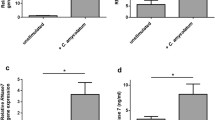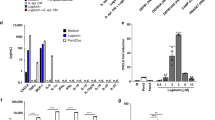Abstract
Antimicrobial peptides of the β-defensin family are expressed in all human epithelial tissues tested to date and have recently been the subject of vigorous investigation. Their localization and characteristics support the hypothesis that these peptides play a role in mucosal and skin defense. The lipophilic yeast Malassezia furfur is a saprophyte found in normal human cutaneous flora. Malassezia furfur is not only a saprophyte, but is also associated with several diseases such as Malassezia folliculitis, seborrheic dermatitis and some forms of atopic dermatitis, psoriasis and confluent and reticulate papillomatosis. Little is known about the mechanism by which M. furfur overcomes the natural barrier of the skin. To further define the role of the β-defensins in the innate human skin immune response, we analyzed the mRNA expression of two human β-defensins HBD-1 and HBD-2 in human keratinocytes treated with M. furfur. In addition, we looked into how M. furfur of TGF-β1 and IL-10, cytokines that interfere with the development of protective cell immunity, regulate their expression. Finally, we examined the signal transduction mechanisms involved during M. furfur uptake. Cultured human keratinocytes were treated with M. furfur. The mRNA and protein expression were analyzed, respectively, by reverse transcriptase polymerase chain reaction (RT-PCR) and Western blotting. Our data demonstrate that M. furfur does not modify HBD-1 expression, whereas it up-regulates, via protein kinase C (PKC), the expression of HBD-2, TGFβ-1 and IL-10 48 h after treatment. Our results suggest that β-defensins are integral components of innate host defenses. They play an essential part in the resistance of the human skin surfaces against M. furfur uptake and other microbial invasion.






Similar content being viewed by others
References
Andrews NC, Faller DV (1991) A rapid micropreparation technique for extraction of DNA-binding proteins from limiting numbers of mammalian cells. Nucleic Acids Res 19:2499–2506
Angel P, Karin M (1991) The role of Jun, Fos and the AP-1 complex in cell-proliferation and transformation. Biochim Biophys Acta 1072:129–157
Ashbee HR, Evans EG (2002) Immunology of disease associated with Malassezia species. Clin Microbiol Rev 15:21–57
Baroni A, Perfetto B, Paoletti I, Ruocco E, Canozo N, Orlando M, Buommino E (2001) Malassezia furfur invasiveness in a keratinocyte cell line (HaCat): effects on cytoskeleton and on adhesion molecule and cytokine expression. Arch Dermatol Res 293:414–419
Bensch KW, Raida M, Magert HJ, Schulz-Knappe P, Forssmann WG. (1995) HBD-1: a novel beta-defensin from human plasma. FEBS Lett 368:331–335
Bergbrant IM, Faergemann J (1990) The role of Pityrosporum ovale in seborrheic dermatitis. Semin Dermatol 9:262–268
Bradford M (1976) A rapid and sensitive method for the quantification of microgram quantities of protein utilising the principle of protein dye binding. Anal Biochem 72:248–256
Casatorres J, Navarro JR, Blessing M, Jorcano JL (1994) Analysis of control of expression and tissue specificity of the keratin 5 gene, characteristic of basal keratinocytes. Fundamental role of an AP-1 element. J Biol Chem 269:20489–20486
Faergemann J (1992) Pityrosporum infections. In: Elewski BE (ed) Cutaneous fungal infections. Igaku-Shoin, New York, pp 69–83
Fulton C, Anderson GM, Zasloff M, Bull R, Quinn AG (1997) Expression of natural peptide antibiotics in human skin. Lancet 350:1750–1751
Harder J, Bartels J, Christophers E, Schroder JM (1997) A peptide antibiotic from human skin. Nature 387:861–862
Hill CS, Treisman R (1995) Transcriptional regulation by extracellular signals: mechanism and specificity. Cell 80:199–211
Hirsch CS, Yoneda T, Averill L, Ellner JJ, Toossi Z (1994) Enhancement of intracellular of Mycobacterium tuberculosis in human monocytes by transforming growth factor B1. J Infect Dis 170:1229–1237
Krisanaprakornkit S, Weinberg A, Perez CN, Dale BA (1998) Expression of the peptide antibiotic human beta-defensin 1 in cultured gingival epithelial cells and gingival tissue. Infect Immun 66:4222–4228
Krisanaprakornkit S, Kimball JR, Dale BA (2002) Regulation of human β-defensin-2 in gingival epithelial cells: the involvement of mitogen-activated protein kinase pathways, but not the NF-κB transcription factor family. J Immunol 168:316–324
Midorikawa K, Ouhara K, Komatsuzawa H, Kaway T, Yamada S, Fujiwara T, Yamazaki K, Sayana K, Taubman MA, Kurihara H, Hashimoto K, Sugai M (2003) Staphylococcus aureus susceptibility to innate antimicrobial peptides, β-defensins and CAP18, expressed by human keratinocytes. Infect Immun 71:3730–3739
Niyonsaba F, Hirata M, Ogawa H, Nagaoka I (2003) Epithelial cell-derived antibacterial peptides human beta-defensins and cathelicidin: multifunctional activities on mast cells. Curr Drug Targets Inflamm Allergy Sep;2(3):224–231
Reed SG, Brownell CE, Russo DM, Silva JS, Grbstein KM, Morrisey PJ (1994) IL10 mediates susceptibility to Trypanosoma cruzi Infection. J Immunol 153:3135–3140
Roman MJ, Coriz PD, Baca OG (1986) A proposed model to explain persistent infection of host cell with Coxiella burnetii. J Gen Microbiol 132:1415–1422
Rossi A, Jang SI, Ceci R, Steinert PM, Markova MG (1998) Effect of AP-1 transcription factors on the regulation of transcription in normal human epidermal keratinocytes. J Invest Dermatol 110:34–40
Rozina SA, Falconer A, Ikram M, Bisset CE, Cerio R, Quinn AG (2001) Expression of the peptide antibiotics human β-defensin-1 and human β-defensin-2 in normal skin. J Invest Dermatol 117:106–111
Rutberg SE, Saez E, Glick A, Dlugosz AA, Spiegelman BM, Yuspa SH (1996) Differentiation of mouse keratinocytes is accompanied by PKC-dependent changes in AP-1 proteins. Oncogene 13:167–171
Schapp D, Harris A (1998) Antibacterial peptides in bronchoalveolar lavage fluid. Am J Respir Cell Mol Biol 19:352–356
Schibli DJ, Hunter HN, Aseyev V, Starner TD, Wiencek JM, McCray PB Jr, Tack BF, Vogel HJ (2002) The solution structures of the human β-defensins lead to a better understanding of the potent bactericidal activity of HBD3 against Staphylococcus aureus. J Biol Chem 277:8279–8289
Schröder JM (2000) Mucoid Pseudomonas aeruginosa, TNF-α, and IL1-β, but not IL-6, induce human β-defensin 2 in respiratory epithelia. Am J Respir Cell Mol Biol 22:714–721
Scott MG, RE Hancock (2000) Cationic antimicrobial peptides and their multifunctional role in the immune system. Crit Rev Immunol 20:407
Singh PK, Jia HP, Wiles K, Hesselberth J, Liu L, Conwei BA, Greenberg EP, Valore EV, Wersh MJ, Ganz T, Tack BF, McCray PB Jr (1998) Production of β-defensins by human airway epithelia. Proc Natl Acad Sci U S A 95:14961–14966
Svendsen ML, Daneels G, Geysen J, Binderup L, Kragballe K (1997) Proliferation and differentiation of cultured human keratinocytes is modulated by 1,25(OH)2D3 and synthetic vitamin D3 analogues in a cell density-, calcium- and serum-dependent manner. Pharmacol Toxicol 80:49–56
Valore EV, Park CH, Quayle AJ, Wiles KR, McCray PB, Hand JR Jr, Ganz T (1998) Human β-defensin-1: an antimicrobial peptide of urogenital tissue. J Clin Invest 101:1633–1642
Warwick-Davies J, Lowrie DB, Cole IJ (1995) Selective deactivation of human monocyte function by TGFβ. J Immunol 155:3186–3193
Weinberg A, Krisanaprakornkit S, Dale BA (1998) Epithelial antimicrobial peptides: review and significance for oral applications. Crit Rev Oral Biol Med 9:399–414
Woodgett JR, Pulverer BJ, Nikolakaki E, Plyte S, Hughes K, Franklin CC, Kraft AS (1993) Advances in second messenger and phosphoprotein research: regulation of Jun/AP-1 oncoproteins by protein phosphorylation. In: Brown BL, Dobson PRM (eds) Raven Press, New York, p 261
Yamamura MK, Uyemura K, Deans RJ, Weinberg K, Rea TH, Bloom BR, Modlin RL (1999) Defining protective responses to pathogens: cytokine profiles in leprosy lesions. Science 254:277–279
Author information
Authors and Affiliations
Corresponding author
Rights and permissions
About this article
Cite this article
Donnarumma, G., Paoletti, I., Buommino, E. et al. Malassezia furfur induces the expression of β-defensin-2 in human keratinocytes in a protein kinase C-dependent manner. Arch Dermatol Res 295, 474–481 (2004). https://doi.org/10.1007/s00403-003-0445-0
Received:
Revised:
Accepted:
Published:
Issue Date:
DOI: https://doi.org/10.1007/s00403-003-0445-0




